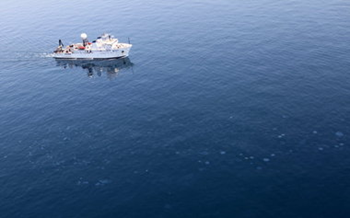LSU confirms Gulf oil sheens are from BP Deepwater Horizon well
While the source of the oil bubbling up around the Deepwater Horizon site remains a mystery, a Louisiana State University scientist says further chemical analysis has confirmed that the oil originated in BP’s well, and not from other nearby sources, as federal officials have suggested. Federal officials said Friday that they have collected samples of the oil rising to the Gulf’s surface near the wellhead in the weeks since the Press-Register went to the site and sent samples to LSU. […] The Press-Register documented oil bubbling to on the surface on Aug. 23 at the site where the Deepwater Horizon rig exploded in April 2010, killing 11 workers and spawning the Gulf oil spill. Bonny Schumaker — a pilot with the non-profit organization On Wings of Care — first saw oil on the surface in that area on Aug. 19. She said she has flown over the site every week since and has seen oil each time. “We did take some samples, but there wasn’t enough in the samples to determine the source,” said Ben Sherman, a NOAA spokesman. “We are planning future sampling in the vicinity of the wellhead.” […] After LSU analyzed the samples provided by the Press-Register, scientists with both BP and the government contacted Ed Overton — the LSU chemist who did most of NOAA’s oil analysis during the spill — to suggest additional parameters he might test to confirm the oil came from BP’s well. […] Overton said federal officials were wrong. He said he rechecked the newspaper’s oil samples using the more refined analysis recommended by BP’s scientists and federal officials. “They were suggesting I had jumped the gun when I said it matched (BP’s well),” Overton said last week. “They are incorrect. I have double-checked, and I am even more convinced after using the suggestions that BP made that this was the Macondo oil. I think it is 99.9 percent confirmed that it came from that reservoir. “It is a dead-ringer match. I was amazed that the ratios matched as good as they did.” Overton said BP also provided him with samples from nearby oil sources, none of which matched the oil collected by the newspaper. […] BP officials declined to answer whether the company would use a hydrocarbon sniffer, which can trace oil in the water column from the surface to the seafloor. “This is crazy. I don’t understand why they are not doing that,” said Overton, who with his colleagues recently earned NOAA’s “Superior Accomplishment Award” for oil analysis done for the government during the oil spill. “Whether it is coming from the well itself, or coming from the riser pipe, you can’t say unless you go down there and look,” Overton said. “There’s oil coming up. Where is it coming from? Send an ROV with a sniffer down and see if you see anything. As much money as has been spent, go spend a little more instead of denying that there is a problem.”
